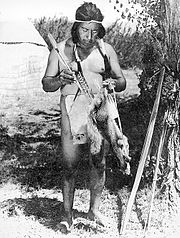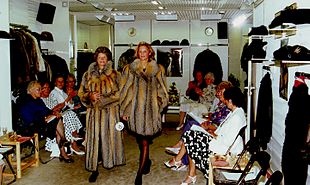Gris fox fur
In wholesaling and retailing, the fur of the North American gray fox or gris fox is usually offered as gris fox fur , the term gray fox was used more often in the past for gray-colored foxes from other origins, in particular for South American foxes.
For the skins of the South American battle fox see → red fox fur , for skins of the North American kit fox and the swift fox see → kit fox fur .
hide
The gris fox fur, in the past often wrongly also called the gries fox fur, is smaller than that of the red fox, it also has noticeably short paws, but a relatively long, bushy tail. It is 53 to 73 cm long, the tail 28 to 40 cm.
The guard hair is coarse and stiff and compared to the red fox shorter, the quite soft undercoat is very dense. The back is colored peppery and salt-like due to the black and white banding of the guard hairs, i.e. silvery or darker gray-black, from which the name of the animal is derived. The cheeks, the chest and the dewlap are rusty yellow to copper red, the tail is grayish and has a broad, deep black stripe on top. The hair along the middle of the back and the top of the tail look like a black mane due to the dark hair tips. The tail hair differs from that of the red fox and other fox species, it is not even all around, but increases in length on the underside. Depending on the occurrence or the geographic races, there are a number of differences in coat size and color. The birth dress is black.
Zoologically there are two types, the much smaller and darker island gray fox and the mainland gray fox , only the latter is important for the fur trade.
The durability coefficient for the gris fox fur is given as 50 to 60 percent. When the fur animals are divided into the fineness classes silky, fine, medium-fine, coarse and hard, the gris fox hair is classified as coarser.
trade
In the mainland gris fox, the trade differentiates between
Eastern ( Colorado , Missouri , Texas , Rocky Mountains , etc.) with short-haired, silky fur, silvery back, rusty yellow dewlap
and Western ( New York State , Pennsylvania , Virginia , Georgia , etc.) full (“heavy”) hair, blackish-gray back and up to copper-red dewlap.
In 1936 an even more differentiated classification into Northern , Central , Coast and Southwestern was given.
Toltec with gris fox fur jewelry , ritual dance, 2012 (the gris fox does not occur in Central America, however)
In addition to their area of origin, the skins are sorted according to the quality of the hair density . The Eastern and Western have the thickest fur that makes the hair stand upright. In the fur industry, this is referred to as "smoke" for all types of fur, in contrast to skins with a thin hair density and flat-lying army. Centrals are not as dense in the hair and therefore appear very flat. Coasts from the coastal region are much paler than the centrals from the interior, but have the same structure. The rest of the areas supply all of the skins " that are too bad to be used for anything other than low-cost products ."
The pelts obtained in the coldest part of winter have a soft, first-class coat, free of any bluish spots. The hair density is usually sufficient and the guard hair is much softer than in the lower qualities. They belong in the best variety, the ones or firsts.
Second qualities, the twos or seconds, originate from the season until shortly before the peak of winter. They only have a slightly bluish tint, a soft awn and are almost as full in the hair as the best goods. The skins obtained after the coldest period also fall into this quality level, as a rule they can be recognized by the reddish spot on the head and shoulders and by the somewhat harder leather.
The even lower qualities are classified as the third type, threes, and the very small, flat, undesirable skins as the last, fourth level, the fours.
A further division is made according to the fur size, also in four levels: extra large, large, medium and small. As a rule, the medium-sized pelts, the mediums, have the softest fur and the most beautiful hair appearance. This is probably due to the fact that it is mainly the skins of female animals and male foxes in the first year of life.
The delivery of raw skins usually happens around deducted, with the hair outward. Only the Southern and Southwestern were, at least until the 1930s, open pelted.
America exported 20,000 to 40,000 pelts annually after 1900; In 1923/24 the total was about 80,000; In 1950 there were 100,000 skins. Around 1988 around 250,000 to 300,000 pelts were sold annually, around half Eastern and Western.
Gris fox skins always come from animals in the wild. Compared to other fox fur types, mostly from breeding, the number of gris fox fur is very low.
Refinement, processing
In 1911, the tobacco shop Emil Brass noted : “ The fur cannot be used for food, only for stoles and sleeves. Even the tail and claws cannot be used for anything other than decorating stoles. Sometimes the undercoat is also colored dark blue, while the white tips keep their color. The current average is about 10 marks per hide. "1940 wrote the Leipziger" furrier newspaper "" ... they will naturel or stained blue to ties , shrikes , hunting sleeves and ceiling , more recently, sporadic jackets and capes processed "in a Head Shop textbook it was in 1986, in contrast to Brass, but obviously now, in terms of use, already very out of date, the gris fox is of little value because of its short, hard hair and " is used for feeding travel fur ".
The fur, which is quite short-haired for a fox with its lively color scheme, was now also used a lot for jackets and coats after the Second World War and, since the 1990s, increasingly, sometimes fashionably colored, for trimmings and hood trimmings. Even today, the natural color structure is retained when dyeing, as the hard awn takes on the color to a much lesser extent than the soft undercoat. For general refinement, see the main article → Pelzveredlung .
Since the introduction of the fur sewing machine around 1900 (invented around 1870), it has been possible to change the shape of the skins as required by so-called skipping at economic costs . With narrow V- or A-shaped cuts, the skins are brought into any desired length at the expense of the width, up to a floor-length evening coat (see photo).
As with almost all types of fur, the remains of the gris fox, especially the paws and sides, are put together to form panels and are sold as so-called bodies for further processing. The main place for the recycling of the fur residues in Europe is Kastoria in Greece and the smaller town Siatista, which is nearby . The tails are used as pendants for key rings, bags, etc., and also as boas when fashionable , although they are less soft and have a smaller volume than the tails of most other fox species.
numbers
Detailed trade figures for North American tobacco products can be found at
- Emil Brass: From the realm of fur . 1st edition, published by the "Neue Pelzwaren-Zeitung and Kürschner-Zeitung", Berlin 1911
- Emil Brass: From the realm of fur . 2nd improved edition, publisher of the "Neue Pelzwaren-Zeitung and Kürschner-Zeitung", Berlin 1925
- Emil Brass: From the Realm of Furs (1911) ( Digitalisat - Internet Archive )
- Milan Novak et al, Ministry of Natural Resources: Wild furbearer management and conservation in North America . Ontario 1987 (English). ISBN 0-7778-6086-4
- Milan Novak et al., Ministry of Natural Resources: Furbearer Harvests in North America, 1600-1984 , Appendix to the above Wild furbearer management and conservation in North America . Ontario 1987 (English). ISBN 0-7729-3564-5
annotation
-
↑ The specified comparative values ( coefficients ) are the result of comparative tests by furriers and tobacco shops with regard to the degree of apparent wear and tear. The figures are ambiguous; in addition to the subjective observations of shelf life in practice, there are also influences from tanning and finishing as well as numerous other factors in each individual case. More precise information could only be determined on a scientific basis.
The division was made in steps of 10 percent each. The most durable types of fur according to practical experience were set to 100 percent.
See also
Individual evidence
- ^ Ronald M. Nowak: Walker's Carnivores of the World. Johns Hopkins University Press, 2005, ISBN 978-0-8018-8032-2 , pp. 83-84.
- ↑ a b c d e f Max Bachrach: Fur. A Practical Treatise. F Verlag Prentice-Hall, Inc., New York 1936. pp. 295-298 (Eng.)
- ↑ Dr. Fritz Schmidt: The book of the fur animals and pelts . FC Mayer Verlag, Munich 1970, pp. 200-203
- ↑ Arthur Samet: Pictorial Encyclopedia of Furs . Arthur Samet (Book Division), New York 1950, pp. 221–222 (Eng.)
- ^ David G. Kaplan: World of Furs . Fairchield Publications. Inc., New York 1974, p. 166
- ↑ Paul Schöps, Kurt Häse: The fineness of the hair - the fineness classes . In: Das Pelzgewerbe Vol. VI / New Series, 1955 No. 2, Hermelin-Verlag Dr. Paul Schöps, Leipzig, Berlin, Frankfurt am Main, pp. 39–40
- ^ A b c Christian Franke / Johanna Kroll: Jury Fränkel ´s Rauchwaren-Handbuch 1988/89 . 10. revised and supplemented new edition, Rifra-Verlag Murrhardt, p. 161
- ^ A b Emil Brass : From the realm of fur . Publishing house of the "Neue Pelzwaren-Zeitung and Kürschner-Zeitung", Berlin 1911, pp. 552–554
- ↑ Dr. Friedrich Lübstorff: World production of fur skins . In: The fur industry , 1953 XXII. Volume 1/2, Hermelin-Verlag Dr. Paul Schöps, Berlin and Leipzig, p. 5. Secondary sources for 1923/24 Brass, for 1930 International Fur Exhibition IPA, for 1950 no information.
- ↑ The little Kürschner lexicon . In: Kürschner Zeitung , Verlag Alexander Duncker, Leipzig December 1940, p. 68
- ^ Friedrich Lorenz: Rauchwarenkunde , 4th edition. Volk und Wissen publishing house, Berlin 1958, pp. 79–80
- ↑ Dr. Heinrich Dathe , Dr. Paul Schöps, with the collaboration of 11 specialists: Fur Animal Atlas . VEB Gustav Fischer Verlag Jena, 1986, pp. 144–145






